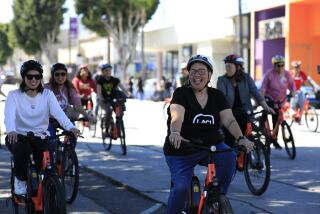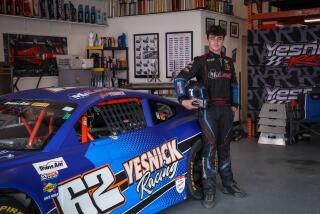Yamaha’s 3-wheel Niken is an exceptional motorcycle. Maybe too exceptional
Yamaha’s three-wheeled Niken represents a magnificent engineering achievement, and a revolutionary step forward in the sport touring motorcycle market.
Will anyone care — or care enough to spend $15,999 to own one?
Yamaha stunned the bike world when it teased the “leaning multi-wheel” machine at the Tokyo Motor Show in late 2017, and then showed a concept version a month later at the European motorcycle show known as EICMA.
The Japanese motorcycle company touted the Niken — said to mean “two swords” — as a dramatic improvement in steering and handling. Its dual front wheels, Yamaha said, offered in effect twice as much tire touching the road, which translated into twice as much traction and twice as much stopping power.
This would make the bike much more stable while cornering on road surfaces compromised by sand, gravel, rain or ice.
Within five minutes of throwing my leg over the Niken, I was sold. It was immediately apparent that the parallel front wheels, while weird to look at, affect the handling and steering of the Niken only in a positive way. It felt exactly like a motorcycle, exactly like any upright sport bike, except when it was pushed hard in a turn. And then it felt better.
Three’s company, or a crowd? Polaris and Vanderhall three-wheeled autocycles ride a growing trend »
It would also make the bike potentially faster. The Niken would be capable of a lean angle of up to 45 degrees, they said — quite a lot more than most riders will ever use — though it starts scraping its footpegs on the asphalt much before that. So a Niken could steer more sharply around a corner, at higher speeds, than a two-wheeled counterpart.
What it would not do, Yamaha said, was stand up on its own. Unlike the three-wheeled auto-cycles such as Can-Am’s Spyder, Polaris’ Slingshot and Vanderhall’s Venice, or three-wheeled scooters such as the Piaggio MP3, the Niken has to be ridden like a regular motorcycle and parked using a traditional kickstand.
To determine who would want such a machine, and why, I borrowed a Niken from Yamaha and spent a couple of weeks testing it.
Since I had recently ridden Yamaha’s Tracer 900 GT sport touring bike, the Niken engine was familiar to me. The two motorcycles share the same 847cc powerplant. It is an in-line three-cylinder engine that revs up fast and is said to produce 115 horsepower.
And, since I had recently ridden a three-wheeled Can-Am Ryker, and had been impressed by a Harley-Davidson customized by Seattle’s Tilting Motorcycle Works, I was pretty sure I wouldn’t find the twin-front-end construction too awkward.
The Niken weighs in at 580 pounds, which is more than 100 pounds heavier than the Tracer 900 GT. It features a six-speed transmission, with a chain drive. The bike offers several riding modes, and clutchless “quick shift” gear changes.
Stopping power comes from three large discs, two in front, one in back, and ABS is standard. Front and rear suspension — four shocks in front, one mono-shock in back — are fully adjustable. The bike features a 32.3-inch seat height.
Adventure bikes are the liveliest segment of a stale motorcycle market »
The result is the most fun I’ve had on three wheels since I got my first tricycle.
The Niken felt instantly comfortable, cruised the highway like a Honda Gold Wing and tackled the twisties like a Ducati Monster. The dual front end offered tremendous grip and feedback. I could feel every wrinkle in the road and the Niken absorbing the rough stuff beautifully.
I assumed at first, sitting over the wide front end, that the multiwheel construction would compromise its ability to lane-share on the freeway. But I quickly realized that the front tires do not sit wider than the handlebars. Soon I was splitting lanes as comfortably as I do on anything made by Harley-Davidson or Indian Motorcycle — cautiously, but comfortably.
In fact, it was at times more comfortable than on a conventional motorcycle, because the space between the two front wheels allowed me to straddle the center line and the Botts Dots that sometimes make lane splitting bumpy.
Yamaha calls the Niken a “sport touring motorcycle,” and sells the bike in standard trim for $15,999 and a GT version for $17,299. The extra MSRP for the GT buys touring accessories including a taller windscreen, quick-release saddle bags, a grab rail for the rear passenger, a center stand and an extra 12-volt electrical outlet.
Everywhere I went on the Niken, I met riders who were drawn by its weird Transformer face and two-wheeled front end. They wanted to know how much it cost, how much it weighed and whether it would wheelie. (Ari Henning, in an episode of Motorcyclist magazine’s “On Two Wheels,” demonstrated that it can.)
The still-unanswered question, for me, is: Who is the buyer for the Niken?
It’s clearly not a beginner’s bike, with that powerful a motor and that high an MSRP. It’s not a track bike, despite its potential lean angle, unless one were to start moving footpegs, kick stand mount and other parts likely to scrape in a deep turn.
So, maybe the customer for the Niken and Niken GT is the rider who often rides on surfaces with reduced traction — roads in California that have unexpected patches of sand or gravel, or roads in other places plagued by patches of ice or slickened by persistent rain.
Or, maybe there isn’t much of a customer at all. So far, the only Niken I’ve seen on the road was the one I was riding.
Yamaha has built an exceptional machine. It might be too exceptional, and in the end nothing more than an elegant solution to a problem that, for most riders, doesn’t even exist.







